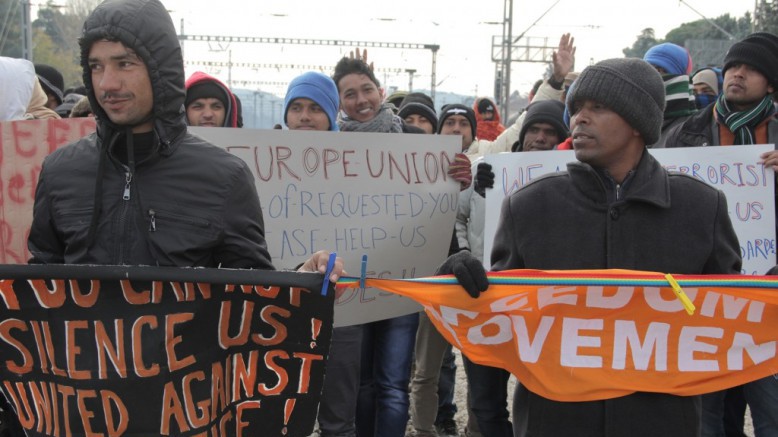Preface | Part 1 | Part 2 | Part 3 | Part 4 | Part 5 | Part 6 | Part 7
Moving Europe: Summer of Migration – Preface
PDF Download: Moving Europe: Summer of Migration – Preface
Those people who die on the beaches (…) and if they were White the whole world would be trembling. (…) When the poor come to you, it’s a crush movement which has to be blocked, but when you with your passport and all the arrogance what that brings, you disembark in the third world and you are on conquered land. So you see the poor who move but you do not see the rich who invest in our countries. (…) We must end this hypocrisy: We will be rich together or we will all drown together.[1]
History was made on the Aegean and the West Balkan route in the summer of 2015. If all participants and commentators had not realised this before, they did at the latest on that memorable 4th September: When the March of Hope did not end with a massacre on the highway or in Hungarian camps, but instead with people arriving at Munich train station a day later and being welcomed with applause by rows of supporters.
The following text offers a chronology of the events, highlighting and documenting the borderstruggles along the Balkan route – not yet from the perspective of people on the move themselves, and therefore of provisional character. The text is not much more than an explanation of the images presented in the media, and the construction of a timeline.
In times when political thought alternates between social technologies and bombardments, the strength of social movements is often underestimated. This includes the dynamics within which migratory movements take shape. The passages across the Aegean have become an increasingly important axis of migration, while IOM expects the number of passages across the Mediterranean to further increase during the winter. These passages could only be halted by paying a very high price: the price of an excessive militarisation of the Mediterranean and the construction of camps in the German periphery. The decisions from Brussels aim to control and contain migration. The bombardment is to be supplemented with lunch packets. Turkey received three billion euros. Greece has to comply.
History has not been decided upon yet. Europe is hesitant, politicians believe that they can still maintain the external migration regime with some sort of cordon sanitaire around the Mediterranean and solve the internal „refugee problem“ with the old-style means of social policies. But there is no turning back. One million refugees and migrants are enough to change the face of Central Europe, and it will only be a few months before one million becomes two million. Europe is at a crossroads: either it can go down the road of more military, repression and camps – or let a social transformation take place with an open ending and a culture of welcome, which would need to comprehend the departure of Syrians originating from the Arabellion, the imagination of Africans and the search for opportunities for children as a demand to revive Europe in the context of diverse basic democratic movements.
Which categories can serve to describe the Arab Revolution in its 5th year, together with the migratory movements that originated from these uprisings?
Referring to Asef Bayat, Helmut Dietrich speaks about „everyday patterns“ of mobilisation by „collective and non-collective actors“.[2]
Arjun Appadurai emphasises the relationship between migration and self-discovery in the era of interactive media, and points towards the importance of voice, agency and debate for the emergence of new imagined societies, which can unfold their effects in the diaspora.[3]
Peter Gatrell rewrites the history of migratory movements in the 20th century as the interaction of statehood and the making of migrants, concluding that states make refugees, but „refugees also make states“.[4]
These are contributions to an analytical repertoire, which could enable the development of an understanding of the internal dynamics of migratory movements – but the paramount contribution will come from the articulations of people on the move themselves. We should not suffocate these voices in premature interpretations and demands of integration, but rather tend to listen to these voices and open up a dialogue.
CONTENT
1 Through Bulgaria
2 Idomeni – Gevgelija
3 Welcome to Serbia
4 March of Hope
5 Minefields
6 The Humanitarian Corridor
7 Idomeni in Autumn
Disclaimer
This chronicle partially uses texts and material from the internet resources of relevant groups, sometimes without correct citations. Pictures could be only partially checked for possible copyright reservations. We kindly ask any rights holders to consider that this chronicle is itself Open Source and aims to serve a good cause.
[1] Fatou Diome, quoted in http://ffm-online.org/2015/12/26/callout-for-transnational-actions-on-the-6th-february-2016/#more-35922
[2] http://ffm-online.org/2015/12/15/das-jahr-v-der-arabischen-revolution/
[3] Arjun Appadurai, Streben nach Hoffnung, Blätter 1/2016, 95
[4] Peter Gatrell, The Making of the Modern Refugee, Oxford 2013

